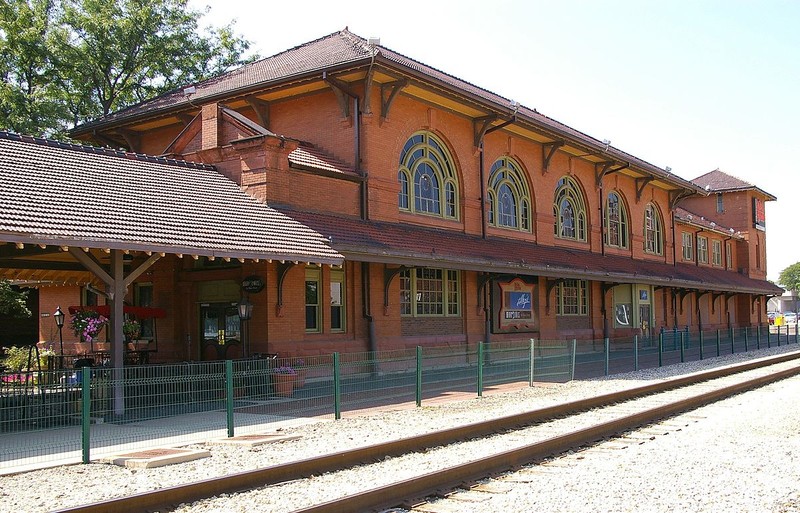Rock Island Depot and Freight House (A.K.A. River Station)
Introduction
Text-to-speech Audio
Built in 1900, this historic Rock Island depot has been restored and serves as a reminder of the significance of railways in the Midwest during the last half of the nineteenth century and the early twentieth century. For Peoria, railways were linked to its burgeoning industries from the production of farm implements to distilleries. The river and rail connections near this depot connected the city to Chicago and other urban areas and was central to Peoria's population growth and economic development in these years. The former rail hub is now home to retail establishments and restaurants.
Images
Rock Island Depot and Fright House (Peoria, IL)

Backstory and Context
Text-to-speech Audio
The two-story Rock Island Depot and Freight House opened in 1900 situated next to the Illinois River. Thanks to preservationists, the building serves as a monument to the importance of the railway to Peoria (and elsewhere) during the late nineteenth century and into the early twentieth century. The depot largely served a branch of the Chicago, Rock Island and Pacific Railroad that delivered goods and passengers to Peoria.
Railway expansion, primarily attached in the Midwest to the growth of Chicago and its hinterlands, as well as western expansionism, compelled engineers to construct bridges across the Mississippi and later the Missouri (necessary for the famous Trans-Continental Railroad). Development of those bridges helped numerous other Midwestern towns connect to major railway branches and, in essence, the Western U.S. (and beyond). As such, bridge building during the 1850s provided a significant economic boost to Peoria, which not only took advantage of its Illinois River location but as an increasingly thriving railway hub.
The Peoria & Bureau Valley was the first railroad to arrive when track was completed and service began on November 7, 1854. By 1880, ten railroads traveled through Peoria. However, the rapid rise in railway lines led to a disorganized web of tracks and, as a consequence, notable congestion. As a result, the Peoria & Pekin Union (P&PU) Railway, which emerged from an 1880 merger of four of the city’s six railroads, decided to construct a modernized train yard; the Peoria Union Station opened in 1882.
With a new yard and modern facilities, the railway industry growth accelerated so that by 1900 railway congestion yet again grew problematic. By the turn of the century, a dozen railroads operated in Peoria (including some sizable operations that had formed as mergers of smaller rail companies). The congestion grew partly because Chicago also suffered from overcrowding of railroads and Peoria was viewed as an alternative hub, including passengers moving east and west throughout the country.
This depot was erected in 1900 by the Peoria & Rock Island Lines Railroad (P & RI) to serve as the third Rock Island passenger depot. Three years later (1903), the much larger Chicago, Rock Island and Pacific railway, a multi-state railroad, acquired P & RI and thus the P & RI transitioned into a branch line of the much larger railroad line.
For many years, the now-historic depot functioned as a major hub, with as many as 21 ticket agents working 24 hours a day, handling 32 daily arrivals and departures. Though passengers routinely used the P & RI, the railway specialized in freight transportation to and from the Great Plains. Much of that freight involved rye and barley from the Great Plains used in Peoria's flourishing distillation industry. During the early 20th century, Peoria's distilleries produced a significant share of the country's blended whiskey, much of it shipped to various points in the Midwest and in western towns throughout the Plains.
Prohibition and the Great Depression had a profound, negative effect on Peoria's economy and subsequent railway traffic. And, similar to any story of railways in the U.S., the depot and trains grew less significant as auto and air travel evolved. Also, sharing the story of many historic train depots, the Rock Island Depot and Freight House has transitioned into a facility that mainly supports the restaurants and bars.
Sources
Jordan, David P. "Railroads and Peoria: A Capsule History." Peoria Magazine. April, 2009. https://www.peoriamagazines.com/ibi/2009/apr/railroads-and-peoria
Montena, Richard M."Nomination Form: Rock Island Depot and Fright House." National Register of Historic Places. nps.gov. December 22, 1978. Digitized PDF located at http://gis.hpa.state.il.us/PDFs/200233.pdf.
Pfieiffer, David M. "Bridging the Mississippi The Railroads and Steamboats Clash at the Rock Island Bridge." Prologue Magazine, vol. 36, no. 2. Published Summer, 2004. National Archives. https://www.archives.gov/publications/prologue/2004/summer/bridge.html
Williams, Karen Lee and Barbara Young-Nesseler. "Nomination for Landmark Designation: Rock Island Lines Passenger Station." Rock Island Preservation Commission. rigov.org. February 6, 1987. https://www.rigov.org/DocumentCenter/View/1049/rockislanddepot?bidId= . Though this citation details the station in Rock Island, it provides input into the line that served Rock Island and Peoria.
Photo Source
Rock Island Depot and Fright House (Peoria, IL): By Ron Reiring - Flickr: Peoria, IL train station, CC BY 2.0, https://commons.wikimedia.org/w/index.php?curid=14638541
Montena, Richard M."Nomination Form: Rock Island Depot and Fright House." National Register of Historic Places. nps.gov. December 22, 1978. Digitized PDF located at http://gis.hpa.state.il.us/PDFs/200233.pdf.
Pfieiffer, David M. "Bridging the Mississippi The Railroads and Steamboats Clash at the Rock Island Bridge." Prologue Magazine, vol. 36, no. 2. Published Summer, 2004. National Archives. https://www.archives.gov/publications/prologue/2004/summer/bridge.html
Williams, Karen Lee and Barbara Young-Nesseler. "Nomination for Landmark Designation: Rock Island Lines Passenger Station." Rock Island Preservation Commission. rigov.org. February 6, 1987. https://www.rigov.org/DocumentCenter/View/1049/rockislanddepot?bidId= . Though this citation details the station in Rock Island, it provides input into the line that served Rock Island and Peoria.
Photo Source
Rock Island Depot and Fright House (Peoria, IL): By Ron Reiring - Flickr: Peoria, IL train station, CC BY 2.0, https://commons.wikimedia.org/w/index.php?curid=14638541
